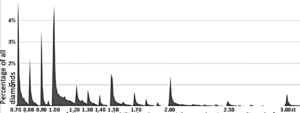- Joined
- Aug 15, 2000
- Messages
- 18,461
I am shortly adding a new additional functionality to HCA.
It will indicate an approximate apparent or Looks Like size of a diamond. Factors used: relative diameter to the stones weight (math formula calculation), edge or peripheral leakage / light return and symmetry. Diamonds can look bigger or smaller depending on cut.
I envisage 4 relative sizes: Bigger, Big, Small and Smaller (or Very Small).
My question to you'all is this.
The boundary between Big and Small - so thinking about 1.00ct rounds only, I am thinking that any diamond that looks at least 0.95ct size could be called Big. Most stones are 0.1 to 0.15mm smaller than optimal. Half the 1.00ct diamonds listed on PS appear smaller than 0.95ct; most PS vendors list better than average stones.
I remember discussions years back where one of our vendors posted many consumers care more about the magic sounding or name like half carat, one carat, two carat etc than all the hoohaa we bang on about.
A guy knows his girl (and her friends and family) will insist on magic / naming rights “It’s a 1ct diamond, will you marry me”.
So I propose the smallest ‘Big’ 1.00ct diamonds at 0.95ct which are usually +6.3mm diameter (or proportional equivalents for any carat weight), and believe it or not, there are some under HCA 2.0 stones on our PS database!
It will indicate an approximate apparent or Looks Like size of a diamond. Factors used: relative diameter to the stones weight (math formula calculation), edge or peripheral leakage / light return and symmetry. Diamonds can look bigger or smaller depending on cut.
I envisage 4 relative sizes: Bigger, Big, Small and Smaller (or Very Small).
My question to you'all is this.
The boundary between Big and Small - so thinking about 1.00ct rounds only, I am thinking that any diamond that looks at least 0.95ct size could be called Big. Most stones are 0.1 to 0.15mm smaller than optimal. Half the 1.00ct diamonds listed on PS appear smaller than 0.95ct; most PS vendors list better than average stones.
I remember discussions years back where one of our vendors posted many consumers care more about the magic sounding or name like half carat, one carat, two carat etc than all the hoohaa we bang on about.
A guy knows his girl (and her friends and family) will insist on magic / naming rights “It’s a 1ct diamond, will you marry me”.
So I propose the smallest ‘Big’ 1.00ct diamonds at 0.95ct which are usually +6.3mm diameter (or proportional equivalents for any carat weight), and believe it or not, there are some under HCA 2.0 stones on our PS database!





300x240.png)